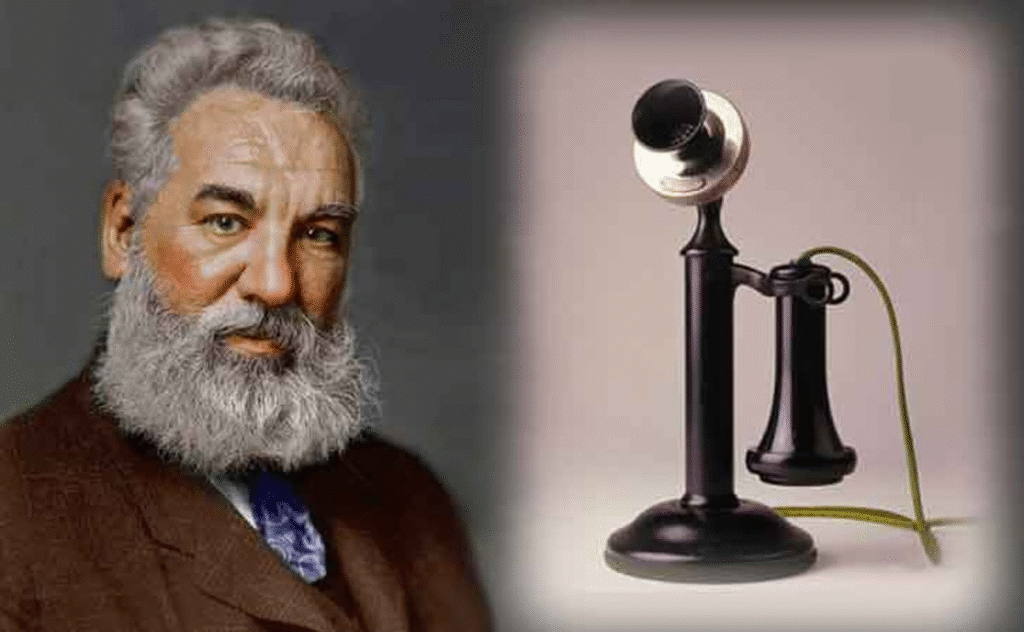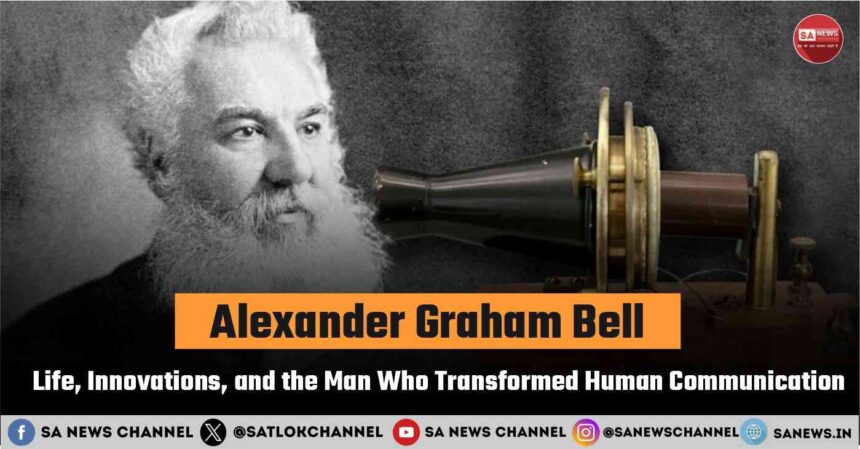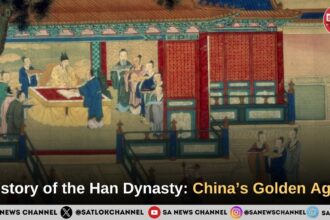Alexander Graham Bell was born on March 3, 1847, in Edinburgh, Scotland, into a family deeply rooted in the study of voice, speech, and elocution. His father, Alexander Melville Bell, was a renowned phonetician known for developing “Visible Speech,” a system that represented spoken sounds through written symbols to help the deaf communicate. His mother, Eliza Grace Symonds Bell, was a gentle and intellectually gifted woman who became gradually deaf during Bell’s childhood. This early exposure to hearing challenges would later define the entire direction of his life.
- Scientific Curiosity and Education
- The Invention Journey: From Sound Experiments to a World-Changing Idea
- The First Telephone Demonstration & Recognition
- Other Inventions & Scientific Pursuits
- Work with the Deaf Community
- Personal Life & Character
- Later Years, Co-Founding National Geographic, Awards, and Legacy
- Spiritual Perspective: Inspiration Beyond Invention
- FAQs About Alexander Graham Bell
As a child, Bell was curious, inventive, and introspective. He spent hours taking apart toys and mechanical objects to understand how they worked. Unlike other children of his age, he was not merely fascinated by play, he was fascinated by “how things functioned.” His mother’s partial deafness forced him to speak distinctly and carefully, which grew into a lifelong desire to understand sound and communication.
Bell was not a consistently brilliant student in the classroom. Instead, he excelled in self-directed learning. He often spent time in his father’s speech laboratory and library, absorbing phonetics, elocution techniques, and experimental science. His grandfather, also named Alexander Bell, recognized his intellectual spark early and encouraged him to think independently rather than conform academically.
In his teenage years, Bell crafted small inventions, including a mechanism that could speak rudimentary words, early proof of his fascination with transferring sound mechanically. The industrial revolution was evolving rapidly across Britain, exposing the young Bell to new engineering possibilities and telegraphy, which later shaped his telephone experiments.
But the greatest emotional influence came from home, the desire to give voice to silence. His mother’s condition was not a limitation for him; it became his motivation.
Scientific Curiosity and Education
Bell’s learning was unconventional. Though he briefly attended the Royal High School of Edinburgh, he did not finish formal schooling there. Instead, he continued under private tutelage and absorbed practical exposure from his father’s work. He later studied at the University of Edinburgh and briefly at University College London, learning about acoustics, physiology of speech, and electrical science.
During these years, his brilliance became more focused: he was not interested in science for status but for application, his scientific drive always had a human purpose. While other inventors were racing to commercialize ideas, Bell was racing to solve communication barriers.
His family later moved to Canada to improve Bell’s health, and this relocation would become the bridge leading him toward North America’s rapidly growing telecommunication research landscape.
The Invention Journey: From Sound Experiments to a World-Changing Idea
When Bell arrived in North America, his primary focus was still on teaching the deaf, not inventing a telephone. He became a professor of vocal physiology and speech at Boston University, where he worked closely with students who were hearing impaired. During this period, Bell’s scientific curiosity and his humanitarian mission began to intersect, he started studying how electrical vibrations could carry sound in the same way telegraph wires carried coded signals.

The telegraph at that time could send only one message at a time over a wire. Bell believed that if he could transmit multiple tones simultaneously, a system called the “harmonic telegraph”, it might be possible for human speech to travel electrically.
This was a bold, nearly unbelievable idea for the scientific community of the 1870s.
Many thought voice transmission through a wire was fantasy. Bell, however, believed communication should not merely be coded, it should be human.
He spent long nights in makeshift laboratories refining oscillations, electrical currents, and membrane vibrations. He collaborated with Thomas Watson, a young, skilled machinist, who translated Bell’s conceptual ideas into physical apparatus and prototypes.
But the journey was not smooth. Bell’s experiments repeatedly failed due to instability in electrical frequencies and mechanical limitations. Investors doubted him. Several scientists were working in the same direction, including the talented inventor Elisha Gray, which created a silent intellectual race.
Yet Bell persisted. What set him apart was not just science, it was empathy. He wasn’t trying to improve a machine. He was trying to improve human connection.
The First Telephone Demonstration & Recognition
The breakthrough moment came on March 10, 1876, inside Bell’s laboratory in Boston. While experimenting with a transmitter, Bell accidentally spilled acid and urgently called out, “Mr. Watson, come here, I want to see you!”
To his astonishment, Watson heard the words clearly through the device in the next room, not vibrations, not Morse code, but speech.
In that instant, human communication entered a new era.
Only three days earlier, on March 7, 1876, Bell had successfully secured the patent for the telephone, beating Elisha Gray by just hours. This timing became one of the most debated patent races in history, but legally and historically, Bell prevailed.

Soon after, the telephone was demonstrated publicly at the 1876 Philadelphia Centennial Exposition. Audiences were stunned, some even believed it was a trick. Newspapers called it “the talking telegraph,” unaware they were witnessing a revolution.
Funding soon followed. Bell Telephone Company was founded in 1877, and within a few short years, telephones began appearing in government offices, businesses, and eventually private homes. Communication, once limited by distance and delay, became immediate and intimate.
But Bell did not stop to celebrate. Instead of clinging to fame, he kept returning to research, eager to keep innovating.
Other Inventions & Scientific Pursuits
Alexander Graham Bell’s creativity extended far beyond the telephone. While he is universally remembered for connecting voices across distances, he also made pioneering contributions in multiple scientific fields. One of his most notable inventions was the photophone, developed in 1880, which transmitted sound on a beam of light. This device, though largely forgotten at the time, laid the foundation for modern fiber-optic communication.
Bell also worked on hearing devices, improving early hearing aids for the deaf. His understanding of acoustics and vibrations, inspired by personal experiences in his family, allowed him to innovate in this area with both technical and empathetic insight.
Also Read: History of the European Union: From War-Torn Continent to Unified Bloc
He explored aviation as well, experimenting with kites and early powered aircraft designs. Bell developed the tetrahedral kite, a concept that contributed to aerodynamic research. Additionally, he experimented with hydrofoils, attempting to create fast watercraft, and even worked on early metal detection devices, one of which famously helped locate a bullet in President James Garfield after an assassination attempt.
Bell’s scientific philosophy was consistent: every invention should improve human life. His work reflected a rare blend of technical brilliance, creativity, and empathy. Unlike inventors motivated purely by fame or profit, Bell often used his inventions to serve others, particularly those marginalized by hearing impairment or physical limitations.
Work with the Deaf Community
From the beginning of his career, Bell was deeply committed to teaching the deaf. He became a professor of vocal physiology and elocution at Boston University and later co-founded the American School for the Deaf, creating specialized programs to teach speech and communication.
Bell developed innovative teaching methods that incorporated visual symbols, electrical devices, and speech analysis. His focus was always on enabling deaf students to communicate effectively with the hearing world, opening opportunities for education and employment that were otherwise inaccessible.
Bell’s most famous student, Helen Keller, though primarily taught by Anne Sullivan, benefited indirectly from Bell’s advocacy and methods for the deaf community. Bell also traveled extensively, giving lectures and spreading techniques for deaf education worldwide. His dedication was recognized as both pioneering and deeply humanitarian.
Bell’s commitment to the deaf went beyond education; it was a moral mission. He viewed communication as a bridge not only between individuals but also as a way to empower those who were often excluded from society.
Personal Life & Character
Alexander Graham Bell’s personal life reflected the same dedication and empathy that defined his scientific work. In 1877, he married Mabel Gardiner Hubbard, a former student who was also deaf. Their relationship was built on mutual respect, shared intellectual curiosity, and a deep understanding of the challenges faced by the hearing impaired. Mabel became a constant source of support, assisting Bell in managing his inventions, experiments, and philanthropic activities.
Bell was known for his calm, patient, and disciplined personality. Colleagues described him as methodical, creative, and relentlessly curious, but never ostentatious. Despite the fame that followed his inventions, he remained humble, often attributing success to collaboration, particularly with his assistant Thomas Watson, rather than personal genius alone
Later Years, Co-Founding National Geographic, Awards, and Legacy
In his later years, Alexander Graham Bell continued to pursue scientific research and innovation while mentoring the next generation of inventors and scientists. He devoted time to improving communication devices, aviation technologies, and optical instruments. Bell’s curiosity never waned, and he remained intellectually active well into his 70s.
One of his most notable contributions beyond inventions was co-founding the National Geographic Society in 1888. Bell served as its second president and played a key role in shaping the organization’s early direction. Under his guidance, the society promoted scientific exploration, geographical research, and education, helping spread knowledge worldwide. This work reflected Bell’s lifelong commitment to both human development and the dissemination of knowledge.
Bell received numerous awards and honors throughout his life, recognizing his groundbreaking contributions to science and communication. These included international accolades for the telephone, honorary degrees from prestigious universities, and acknowledgment from scientific societies. His innovations earned him global respect, and his work inspired generations of inventors and educators.
Alexander Graham Bell passed away on August 2, 1922, at the age of 75, in Baddeck, Nova Scotia, Canada. His legacy endures not only in the ubiquitous telephone and telecommunications technology but also in his humanitarian work, teaching the deaf, and fostering scientific institutions. Bell’s life demonstrates how intellectual brilliance, empathy, and dedication to human progress can leave a lasting impact on the world.
Spiritual Perspective: Inspiration Beyond Invention
Alexander Graham Bell reached extraordinary heights through his intelligence, innovation, and compassion. His inventions, especially the telephone, transformed human communication and improved countless lives. Bell’s dedication, curiosity, and perseverance reflect how human effort, creativity, and service can bring meaningful progress to society. His achievements are truly inspiring and a testament to the power of vision combined with action.
According to the spiritual knowledge revealed by Great Chyren Sant Rampal Ji Maharaj Ji, worldly accomplishments like Bell’s are valuable and admirable, yet they do not satisfy the soul’s deepest longing. Human life is a rare opportunity to seek the Supreme God Kabir Sahib, and attain eternal peace in Satlok, the true home of the soul. Bell’s work connected voices and alleviated silence in the world, while devotion provides a connection to the eternal, guiding the soul toward ultimate liberation.
Bell’s life demonstrates that worldly success and spiritual growth can coexist. Achievements bring comfort and progress in the material world, and devotion leads to the eternal fulfillment of the soul. Those who wish to understand the higher purpose of life are requested to visit Sant Rampal Ji Maharaj’s official website, download His app, or read the books written by Him, to gain the true spiritual knowledge of devotion and liberation.
FAQs About Alexander Graham Bell
1. Who was Alexander Graham Bell?
He was a Scottish-born scientist, teacher of the deaf, and inventor credited with the first practical telephone.
2. Why did Bell become interested in sound and speech?
His mother’s deafness during his childhood inspired him to deeply study hearing, communication, and speech science.
3. Did Bell work on inventions other than the telephone?
Yes, he developed the photophone, improved hearing devices, aviation research, and early metal detection technologies.
4. What motivated Bell’s scientific work?
His innovations were driven by empathy and the desire to improve human life rather than profit or recognition.
5. What challenges did Alexander Graham Bell face during the invention of the telephone?
Bell encountered several obstacles while developing the telephone, including financial constraints, technical failures, and intense competition from other inventors like Elisha Gray. He spent years experimenting with electrical sound transmission, often facing skepticism from the scientific community. Despite setbacks, his persistence and belief in his research eventually led to the breakthrough that became the modern telephone.









